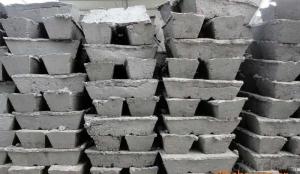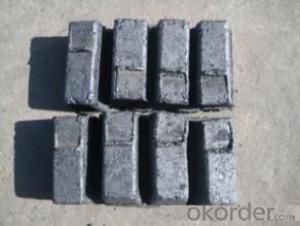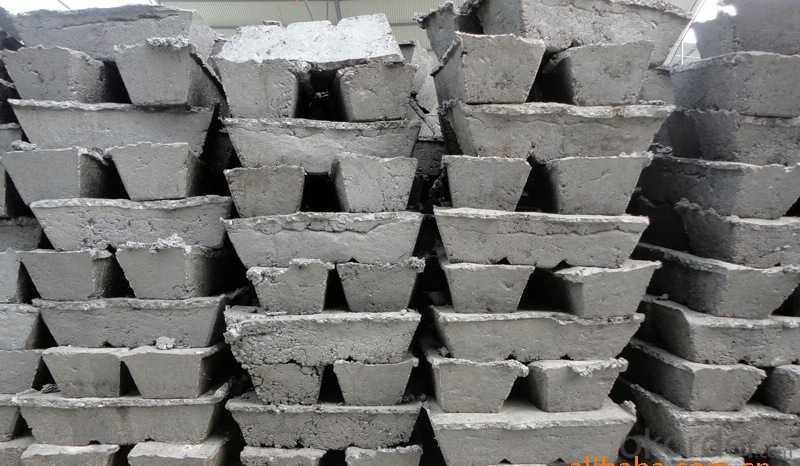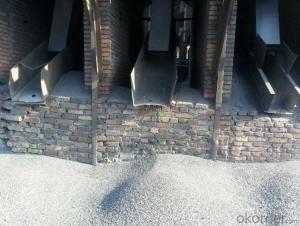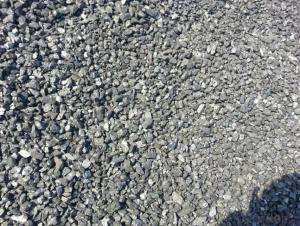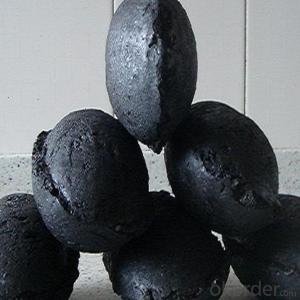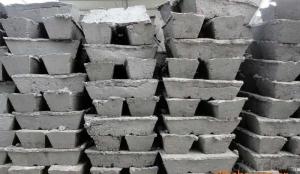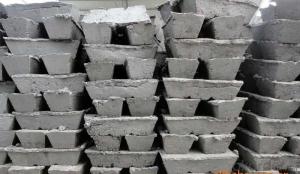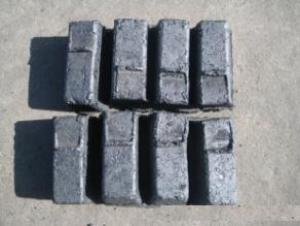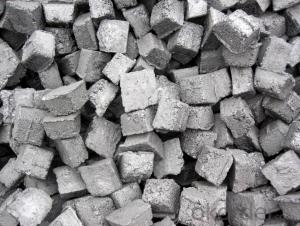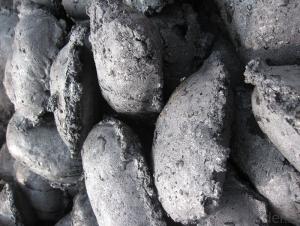Carbon Electrode Paste with low Ash 4-7%
- Loading Port:
- Tianjin
- Payment Terms:
- TT OR LC
- Min Order Qty:
- 20 m.t.
- Supply Capability:
- 3000 m.t./month
OKorder Service Pledge
OKorder Financial Service
You Might Also Like
Spcifications
1:carbon eletrode paste
2:for ferroalloy,calcium carbide manufacture
3:HS 3801300000,YB/T5212-1996,ISO9001:2008
Product Description
Carbon Electrode Paste is a self-baking electrode used in submerged arc furnaces for delivering power to the charge mix. Electrode Paste is added to the top of the electrode column in either cylindrical or briquette form. As the paste moves down the electrode column the temperature increase causes the paste to melt and subsequently bake forming a block of electrically conductive carbon. Electrode Paste is essentially a mix of Electrically Calcined Anthracite (ECA) or Calcined Petroleum Coke (CPC) with Coal Tar Pitch.
Graphite/Carbon Electrode Paste Specification:
PARAMETER UNIT GUARANTEE VALUE
Ash.( % ) 4.0 max5.0 max 6.0 max 7.0 max 9.0 max11.0 max
V.M (%) 12.0-15.512.0-15.5 12.0-15.5 9.5-13.5 11.5-15.511.5-15.5
Compress Strength. 18.0 min17 min 15.7 min 19.6 min 19.6 min19.6 min
Specific Resistance 65 max68 max 75 max 80 max 90 max90 max
Bulk Density 1.38 min1.38 min1.38 min 1.38 min 1.38 min1.38 min
Picture:
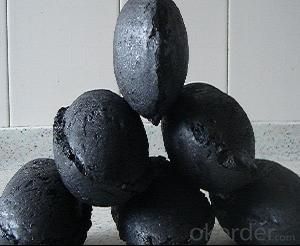
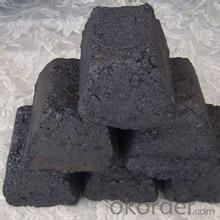
- Q: How does carbon impact the availability of clean water resources?
- Carbon impacts the availability of clean water resources in several ways. Firstly, the burning of fossil fuels releases carbon dioxide (CO2) into the atmosphere, contributing to climate change. This leads to rising global temperatures, which in turn affect the water cycle. Increased evaporation rates and altered precipitation patterns can result in droughts or excessive rainfall, both of which can disrupt the availability and quality of clean water sources. Additionally, carbon emissions contribute to ocean acidification, which harms marine ecosystems and disrupts the delicate balance of marine biodiversity, ultimately affecting the quality and availability of freshwater resources.
- Q: What are the advantages and disadvantages of carbon monoxide and carbon dioxide?
- But traditional carbon monoxide inhalation has the risk of poisoning patients and medical staff by accidental inhalation of high doses of carbon monoxide. That's the advantage. Carbon dioxide is an essential ingredient in plant photosynthesis, and its increase in content is beneficial to the growth of plants. Carbon dioxide can be used as fertilizer to grow crops in greenhouse vegetables. In addition, carbon dioxide can be used as a source of oxygen in diving and aviation. Liquid carbon dioxide has a broad application prospect, the liquid carbon dioxide as extraction medium of naturally occurring compounds from certain plants or plant sources, not only does not damage the bioactive substances contained in the raw material, and the product does not contain residual medium, method for spraying liquid carbon dioxide to the airport in two fog, mist removal efficiency of hundreds of times higher than that of solid carbon dioxide.
- Q: How does carbon contribute to air pollution?
- Air pollution is primarily caused by carbon, which emits carbon dioxide (CO2) and carbon monoxide (CO) into the atmosphere. The burning of fossil fuels like coal, oil, and natural gas releases large quantities of carbon dioxide, a greenhouse gas responsible for global warming and climate change. This excess CO2 traps heat in the atmosphere, resulting in the greenhouse effect and a subsequent increase in global temperatures. Moreover, incomplete combustion of fossil fuels and biomass can release carbon monoxide, a toxic gas with harmful effects on human health. Carbon monoxide is especially dangerous because it binds to hemoglobin in the blood, reducing its ability to carry oxygen and potentially causing asphyxiation. Furthermore, carbon-containing compounds, such as volatile organic compounds (VOCs), also contribute to air pollution. These VOCs are released from various sources, including industrial processes, vehicle emissions, and the use of solvents in paints and cleaning products. When these compounds react with other pollutants in the atmosphere, they form ground-level ozone, a major component of smog. Inhaling ozone can lead to respiratory issues, eye irritation, and other health problems. In summary, carbon plays a significant role in air pollution by emitting carbon dioxide, carbon monoxide, and volatile organic compounds. These pollutants have profound impacts on climate change, human health, and the overall quality of the air we breathe. It is crucial to reduce carbon emissions and adopt sustainable practices to mitigate the adverse effects of carbon on air pollution.
- Q: What are the impacts of carbon emissions on water scarcity?
- Carbon emissions have significant impacts on water scarcity. One of the main ways carbon emissions contribute to water scarcity is through climate change. Increased levels of carbon dioxide in the atmosphere trap heat, leading to global warming and altering weather patterns. This alteration in climate patterns can result in changes to precipitation, such as increased droughts and reduced rainfall in certain regions. Droughts, in particular, can have severe implications for water availability. When there is a lack of rainfall, rivers, lakes, and reservoirs can dry up, leaving communities without access to fresh water sources. This can cause a scarcity of water for drinking, agriculture, and industrial use, affecting both human populations and ecosystems. Furthermore, carbon emissions also impact water scarcity through their effects on melting glaciers and snowpack in mountainous regions. These areas act as natural water reservoirs, releasing water slowly throughout the year and providing a reliable source of freshwater for downstream communities. However, as temperatures rise due to carbon emissions, glaciers and snowpack melt at an accelerated rate. This leads to an increase in water runoff and can result in both flooding and an eventual decrease in water availability during dry seasons. Carbon emissions also contribute to water scarcity indirectly through their impact on sea-level rise. The increased temperatures caused by carbon emissions lead to the melting of polar ice caps, which raises sea levels. As a result, saltwater intrudes into coastal aquifers, making the groundwater brackish or undrinkable. This intrusion can contaminate freshwater sources, reducing their availability and exacerbating water scarcity. Additionally, carbon emissions contribute to the acidification of oceans, which can harm marine ecosystems. This, in turn, affects the availability of seafood resources, which are an essential source of protein for many people around the world. The decline in seafood availability can put additional pressure on freshwater resources, as it may lead to an increased dependence on agriculture, which requires significant amounts of water. In summary, carbon emissions have profound impacts on water scarcity. Climate change, resulting from carbon emissions, alters precipitation patterns, leading to droughts and reduced rainfall. It also accelerates the melting of glaciers and snowpack, reducing water availability in mountainous regions. Furthermore, carbon emissions contribute to sea-level rise, causing saltwater intrusion into freshwater sources. These impacts highlight the urgent need to reduce carbon emissions and mitigate the effects of climate change to ensure the availability of freshwater resources for both present and future generations.
- Q: How does carbon affect the formation of volcanic eruptions?
- The formation of volcanic eruptions can be significantly influenced by carbon. One way in which carbon impacts volcanic eruptions is through the degassing process. When magma rises to the surface, it carries dissolved gases, including carbon dioxide. As the magma moves towards the surface and the pressure decreases, the dissolved gases begin to separate, forming gas bubbles within the magma. These gas bubbles can make the magma more buoyant, facilitating its ascent and eventually leading to an eruption. In addition, carbon can also affect the viscosity of magma, which measures its resistance to flow. Magma with higher carbon content tends to have lower viscosity, making it more fluid-like and capable of flowing more easily. This reduced viscosity enables the magma to move more swiftly towards the surface, increasing the chances of an eruption. Moreover, carbon can contribute to the explosiveness of volcanic eruptions. When magma reaches the surface, it can come into contact with organic matter, such as plant material or fossil fuels, which contain abundant carbon. This interaction can result in the combustion of the organic matter, releasing additional gases like methane. These gases can further elevate the pressure within the volcano, leading to more explosive eruptions. In summary, carbon plays a crucial role in the formation of volcanic eruptions. It influences the buoyancy and viscosity of magma and can contribute to the explosiveness of eruptions. Understanding the impact of carbon in volcanic processes is vital for predicting and mitigating the risks associated with volcanic activity.
- Q: How does carbon impact the prevalence of tropical storms?
- Carbon has a significant impact on the prevalence of tropical storms as it contributes to the warming of the Earth's atmosphere. Increased carbon emissions from human activities, such as burning fossil fuels and deforestation, lead to a rise in global temperatures, which in turn fuels the intensity and frequency of tropical storms. The warmer air holds more moisture, resulting in increased rainfall and the potential for stronger hurricanes. Additionally, carbon-induced climate change can alter atmospheric circulation patterns, creating favorable conditions for the formation and intensification of tropical storms. Thus, reducing carbon emissions is crucial to mitigate the impacts of climate change and potentially lessen the prevalence of tropical storms.
- Q: How does carbon monoxide affect human health?
- Carbon monoxide is a highly toxic gas that can have severe impacts on human health. When inhaled, carbon monoxide enters the bloodstream and binds with hemoglobin, the molecule responsible for carrying oxygen to our cells. This binding is extremely strong and prevents oxygen from being delivered effectively, leading to a condition called carboxyhemoglobinemia. The symptoms of carbon monoxide poisoning can vary depending on the concentration and duration of exposure. Initially, individuals may experience mild symptoms such as headache, fatigue, dizziness, and nausea. However, as exposure continues or at higher concentrations, these symptoms can progress to confusion, impaired judgment, loss of consciousness, and even death. One of the most dangerous aspects of carbon monoxide is its ability to go undetected, as it is colorless, odorless, and tasteless. This makes it challenging to recognize its presence without proper monitoring equipment. Carbon monoxide poisoning can occur from various sources, including faulty heating systems, poorly ventilated appliances, and running engines in enclosed spaces. Prolonged or repeated exposure to carbon monoxide can have long-term health consequences. It can lead to neurological damage, memory loss, cognitive impairment, and even permanent brain damage. Additionally, it can exacerbate existing cardiovascular conditions, increasing the risk of heart attacks and strokes. To protect ourselves from carbon monoxide poisoning, it is crucial to have proper ventilation and functioning carbon monoxide detectors in our homes and workplaces. Regular maintenance of appliances and heating systems is also essential to minimize the risk of leaks. Recognizing the symptoms of carbon monoxide poisoning and seeking immediate medical attention are vital in preventing severe health outcomes.
- Q: How does carbon affect the preservation of historical artifacts?
- Carbon can have both positive and negative effects on the preservation of historical artifacts. On one hand, carbon-based materials such as paper, wood, and textiles are susceptible to degradation over time. These artifacts can be easily affected by environmental factors such as temperature, humidity, and exposure to pollutants, leading to their decay. Carbon-based materials can also be attractive to pests like insects and rodents, further accelerating their deterioration. On the other hand, carbon-based materials like charcoal and carbonates can play a crucial role in the preservation of artifacts. Charcoal, for example, can be used to date artifacts through carbon dating, providing valuable insights into their age and historical significance. Carbonates, such as calcium carbonate found in limestone, can act as protective coatings, forming a barrier against environmental factors and preventing further decay. Moreover, carbon-based conservation treatments, such as consolidation with adhesives or impregnation with polymers, can help stabilize and strengthen fragile artifacts. These treatments can increase the artifact's resistance to environmental factors and provide structural support, extending its lifespan for future generations. It is important to note that while carbon-based materials can impact the preservation of historical artifacts, other factors like light exposure, handling, and storage conditions also play significant roles. Therefore, a comprehensive preservation strategy should consider all these factors to ensure the longevity and conservation of these valuable historical artifacts.
- Q: What is carbon capture and storage?
- The aim of carbon capture and storage (CCS) technology is to lessen carbon dioxide (CO2) emissions from major sources like industrial processes, power plants, and others. It works by capturing CO2 emissions before they are released into the atmosphere and then storing them securely underground. To capture carbon, specialized equipment is typically used to trap CO2 from flue gases or industrial processes. The captured CO2 is then compressed and transported through pipelines or ships to a suitable storage site located deep underground. These storage sites can include depleted oil and gas fields, saline aquifers, or deep coal seams. The storage process ensures long-term containment of CO2 and reduces the risk of leakage. This is achieved by monitoring the storage site for signs of leakage, maintaining the integrity of the storage infrastructure, and selecting suitable sites with geological features that aid in long-term CO2 containment. Carbon capture and storage has the potential to greatly reduce CO2 emissions and contribute to climate change mitigation. By capturing and storing CO2 instead of releasing it into the atmosphere, industries can continue using fossil fuels while minimizing their environmental impact. This is particularly beneficial for industries that are challenging to decarbonize, such as cement production, steel manufacturing, and natural gas power plants. Despite its promise, the widespread implementation of carbon capture and storage faces challenges and limitations. One significant challenge is the high cost associated with establishing CCS infrastructure and operations. Additionally, finding suitable storage sites and addressing public concerns about the safety and environmental impact of underground CO2 injection can pose significant obstacles. Nevertheless, carbon capture and storage is considered an essential tool in the battle against climate change. It can play a crucial role in achieving global emission reduction goals and transitioning to a low-carbon economy. With advancing technology and decreasing costs, the widespread adoption of carbon capture and storage may become increasingly feasible and necessary.
- Q: Today in the market to buy Yuba, instructions have such a word that I don't understand, please master Zhijiao: carbon fiber after energized carbon molecule formation of Brown movement, this movement can be effective in most of the electrical energy into the far infrared.
- Far infrared is produced by vibrational energy level transitions, and its wave number is 400-5000/cm., so carbon and silicon rods are often used as infrared light sources in Analytical Chemistry
Send your message to us
Carbon Electrode Paste with low Ash 4-7%
- Loading Port:
- Tianjin
- Payment Terms:
- TT OR LC
- Min Order Qty:
- 20 m.t.
- Supply Capability:
- 3000 m.t./month
OKorder Service Pledge
OKorder Financial Service
Similar products
Hot products
Hot Searches
